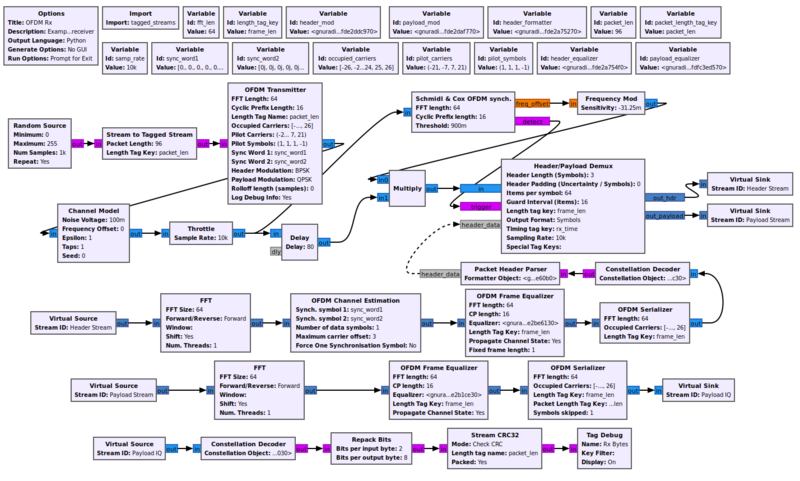Schmidl & Cox OFDM synch.: Difference between revisions
No edit summary |
|||
| Line 30: | Line 30: | ||
== Example Flowgraph == | == Example Flowgraph == | ||
This flowgraph can be found at [https://github.com/gnuradio/gnuradio/blob/master/gr-digital/examples/ofdm/rx_ofdm.grc]. | |||
[[File:Rx_ofdm_fg.png|800px]] | |||
== Source Files == | == Source Files == | ||
Revision as of 03:09, 30 November 2020
Schmidl & Cox synchronisation for OFDM.
- Input
- complex samples.
- Output 0
- Fine frequency offset, scaled by the OFDM symbol duration. This is in [1]. The normalized frequency offset is then 2.0*output0/fft_len.
- Output 1
- Beginning of the first OFDM symbol after the first (doubled) OFDM symbol. The beginning is marked with a 1 (it's 0 everywhere else).
The evaluation of the coarse frequency offset is done in this block. Also, the initial equalizer taps are not calculated here.
Note that we use a different normalization factor in the timing metric than the authors do in their original work[1]. If the timing metric (8) is \f[ M(d) = \frac{|P(d)|^2}{(R(d))^2}, \f] we calculate the normalization as \f[ R(d) = \frac{1}{2} \sum_{k=0}^{N-1} |r_{k+d}|^2, \f] If the timing metric (8) is we calculate the normalization as i.e., we estimate the energy from half-symbols. This avoids spurious detects at the end of a burst, when the energy level suddenly drops.
[1] Schmidl, T.M. and Cox, D.C., "Robust frequency and timing synchronization for OFDM", Communications, IEEE Transactions on, 1997.
Parameters
(R): Run-time adjustable
- FFT Length
- FFT Length
- Cyclic Prefix Length
- Length of the guard interval (cyclic prefix) in samples
- Preamble Carriers
- If true, the carriers in the sync preamble are occupied such that the even carriers are used (0, 2, 4, ...). If you use all carriers, that would include the DC carrier, so be careful.
- Threshold (R)
- detection threshold. Default is 0.9.
Example Flowgraph
This flowgraph can be found at [1].
Source Files
- C++ files
- [2]
- Header files
- [3]
- Public header files
- [4]
- Block definition
- [5]
